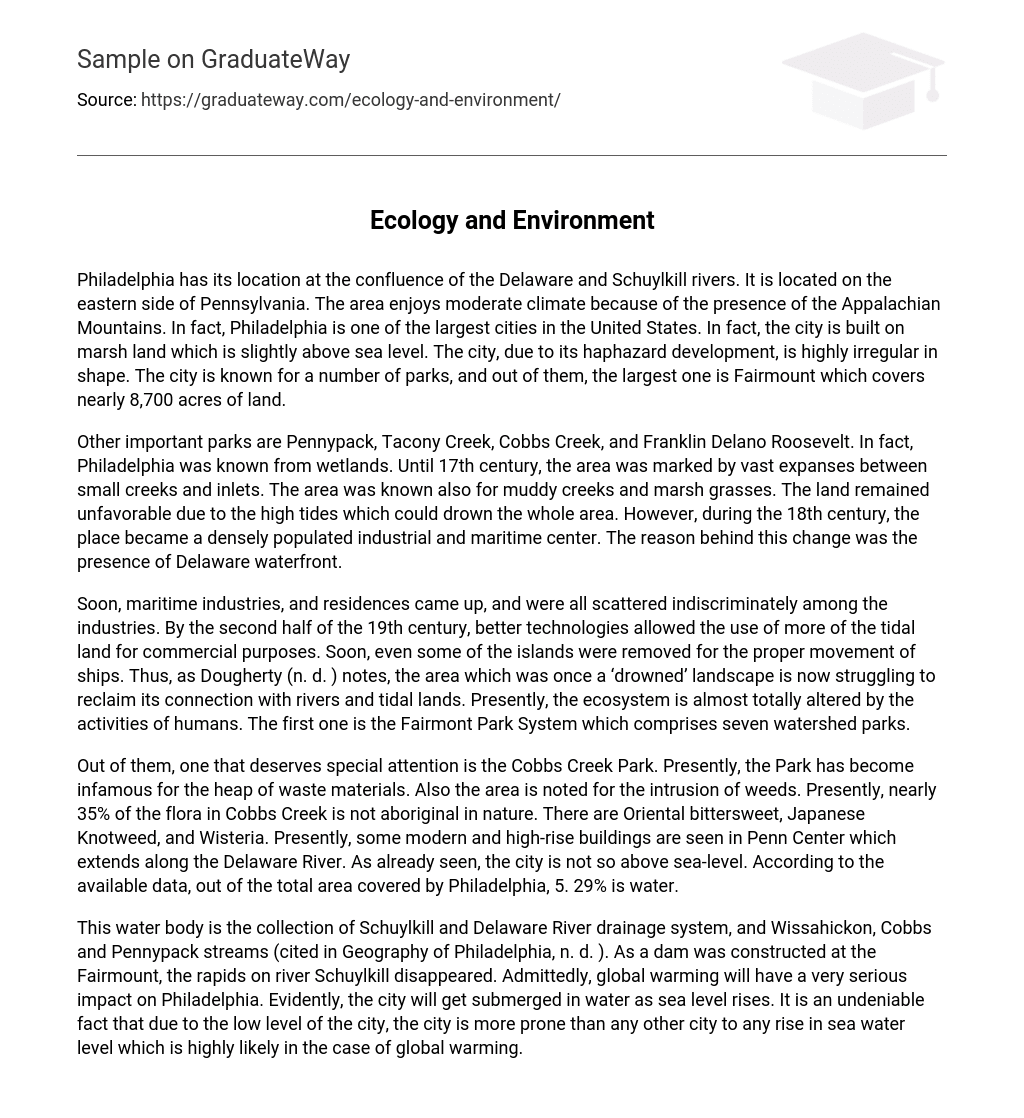Philadelphia has its location at the confluence of the Delaware and Schuylkill rivers. It is located on the eastern side of Pennsylvania. The area enjoys moderate climate because of the presence of the Appalachian Mountains. In fact, Philadelphia is one of the largest cities in the United States. In fact, the city is built on marsh land which is slightly above sea level. The city, due to its haphazard development, is highly irregular in shape. The city is known for a number of parks, and out of them, the largest one is Fairmount which covers nearly 8,700 acres of land.
Other important parks are Pennypack, Tacony Creek, Cobbs Creek, and Franklin Delano Roosevelt. In fact, Philadelphia was known from wetlands. Until 17th century, the area was marked by vast expanses between small creeks and inlets. The area was known also for muddy creeks and marsh grasses. The land remained unfavorable due to the high tides which could drown the whole area. However, during the 18th century, the place became a densely populated industrial and maritime center. The reason behind this change was the presence of Delaware waterfront.
Soon, maritime industries, and residences came up, and were all scattered indiscriminately among the industries. By the second half of the 19th century, better technologies allowed the use of more of the tidal land for commercial purposes. Soon, even some of the islands were removed for the proper movement of ships. Thus, as Dougherty (n. d. ) notes, the area which was once a ‘drowned’ landscape is now struggling to reclaim its connection with rivers and tidal lands. Presently, the ecosystem is almost totally altered by the activities of humans. The first one is the Fairmont Park System which comprises seven watershed parks.
Out of them, one that deserves special attention is the Cobbs Creek Park. Presently, the Park has become infamous for the heap of waste materials. Also the area is noted for the intrusion of weeds. Presently, nearly 35% of the flora in Cobbs Creek is not aboriginal in nature. There are Oriental bittersweet, Japanese Knotweed, and Wisteria. Presently, some modern and high-rise buildings are seen in Penn Center which extends along the Delaware River. As already seen, the city is not so above sea-level. According to the available data, out of the total area covered by Philadelphia, 5. 29% is water.
This water body is the collection of Schuylkill and Delaware River drainage system, and Wissahickon, Cobbs and Pennypack streams (cited in Geography of Philadelphia, n. d. ). As a dam was constructed at the Fairmount, the rapids on river Schuylkill disappeared. Admittedly, global warming will have a very serious impact on Philadelphia. Evidently, the city will get submerged in water as sea level rises. It is an undeniable fact that due to the low level of the city, the city is more prone than any other city to any rise in sea water level which is highly likely in the case of global warming.
Another serious issue, according to The Real Earth watch, is the infrequent and intense rises in temperature which will take many lives. According to the report (The Real Earth watch, Cover story, 2006) nearly 361 people will die of heat by 2020 and the number will rise to 682 by 2050. However, the list is too long. Another serious issue the report points out is that there will be a considerable decline in the number of births as the rise in temperature will be accompanied by a fall in sperm counts. As it is more important to give attention to the ecology, the report points out that a mere 1. degree Fahrenheit rise in the temperature will lead to the disappearance of at least 9 percent of the native bird species in Philadelphia. The birds will fly to other regions for suitable climates. As a consequence, the natural seed dispersal, plant pollination and pest control will all get adversely affected. That means the usual system of pest control and plant growth will be adversely affected. Another problem is with the migratory birds. The usual varieties of birds will be replaced by new varieties of birds.
Another important issue is with the impact of rising temperature of land and water on fish population. It is predicted that the cold-water fisheries will disappear for ever. In addition, as the sea level rises, inundating wetlands along the Jersey shore and the Delaware Bay, the fresh water in the Delaware River will rise in salinity. That means the fish, wildlife, and plants which depended on the river water will be adversely affected. Admittedly, the city of Philadelphia will be one among the most affected cities in the world in case of global warming.
While other port cities mainly face inundation, Philadelphia faces a gradual and easy loss of land, followed by easy loss ecological balance and sustainability.
References
Dougherty, C. (n. d. ). From wetland to urban land: A social and environmental history of Philadelphia’s tidal islands. Phila Place. Retrieved from http://www. philaplace. org/essay/626/ Geography of Philadelphia. (n. d. ). Retrieved from http://www. mapsofworld. com/cities/usa/philadelphia/geography. html The Real Earth watch, Cover story. Retrieved from http://archives. citypaper. net/articles/2006-05-25/cover2. shtml





